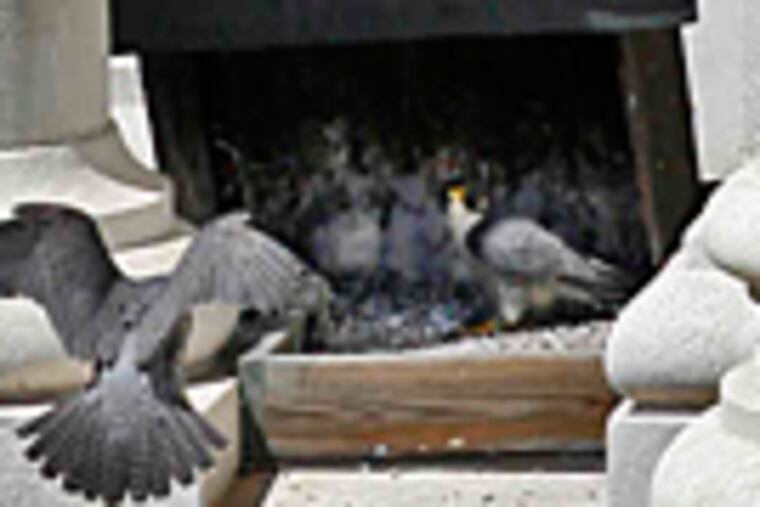At City Hall, a time to prey
He was seen investigating the digs last fall, but folks hoping the couple would move in knew that it depended on her approval.

He was seen investigating the digs last fall, but folks hoping the couple would move in knew that it depended on her approval.
They could have chosen a smokestack, or somewhere under the Ben Franklin Bridge.
But for the first time in nine years, a pair of peregrine falcons have nested on the south side of City Hall's tower.
"Between the scaffolding and the construction that was going on at City Hall, it was disturbing to the peregrines," said Art McMorris, peregrine-falcon coordinator for the state Game Commission. "That's probably the reason that they didn't nest there during that period, but nobody will know for sure."
This pair of peregrine falcons, who, along with the rest of the species, mate for life, are new tenants to City Hall and are the parents of as many as three young chicks, McMorris said.
"We don't know how many, because Mom keeps sitting on them," he said.
McMorris and Ed Mutzer - a volunteer watcher whom McMorris calls the Game Commission's "eyes and ears for peregrine falcons in Center City" - will know soon enough, when they climb the tower to band the chicks next week.
They'll be wearing hard hats and goggles to protect themselves against the protective parents.
"Peregrine falcons, like people, have personalities," McMorris said. "They've even been known to chase after small airplanes."
The first confirmed nesting of peregrines on City Hall dates to 1946, although they are suspected to have nested there since 1918, 17 years after the structure was completed. City Hall is believed to be among the first man-made structures in the world where peregrine falcons have nested, McMorris said.
Before DDT and other pesticides threatened the entire population of peregrines in the 1940s and '50s, 44 nests were counted in Pennsylvania, and all of them, except the one on City Hall, were found on natural cliff ledges, according to McMorris.
Last year, 23 active nests were counted in the state, and all but three were found in man-made structures, including power-plant smokestacks and under the Ben Franklin and the Commodore Barry bridges.
While nesting in an urban environment may seem birdbrained, Philadelphia and other cities offer an abundance of "artificial cliffs" and a plethora of easy prey - namely, pigeons.
"If you wanted to design a bird to feed peregrines, you'd design a pigeon," McMorris said. "It's small enough to take, but big enough to be worthwhile."
Peregrine falcons, predators that hunt birds in flight almost exclusively, are the fastest animals in the world. They can exceed 200 mph in a single dive.
The peregrine falcon was removed from the federal list of endangered species in 1999, but it remains on the endangered-species list in Pennsylvania and many East Coast states.